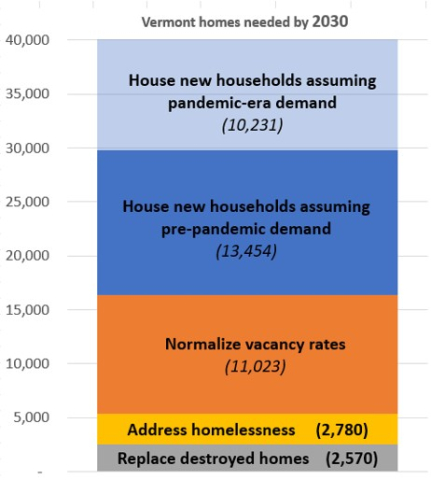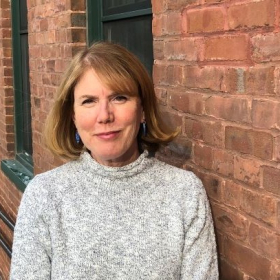Earlier this year VHFA projected a need for 30,000-40,000 more homes by 2030. These projections are based on data from the U.S. Census Bureau and from the Vermont Point-In-Time Count of people experiencing homelessness.They are also based on common assumptions about the drivers of Vermont’s housing needs, such as the ideal vacancy rate among the state’s housing stock.

VHFA’s recent housing need projections exceed earlier forecasts in reports such as the 2020 Statewide Housing Needs Assessment largely because demand to buy or rent a Vermont home increased and because the updated projections include homes needed to balance Vermont’s extremely low vacancy rates. In addition to housing new households and normalizing vacancies, additional Vermont homes are needed to house people experiencing homelessness and to replace homes lost due to housing quality and use conversions.
Increasing demand for homes
Between 2019 and 2021, the number of households living in Vermont increased by 2.8%, from 263,000 to 270,000 according to U.S. Census Bureau estimates. If this rate continues through 2030, Vermont will likely be the home to 24,000 more households by 2030.
Between 2015 and 2019, the number of households living in Vermont increased at an average annual rate of 0.8%, from 255,000 to 263,000. Since heightened demand to live in Vermont is likely due at least in part to the COVID 19 pandemic, VHFA also projected the number of additional households in Vermont by 2030 based on pre-pandemic trends. If the demand to live in Vermont returns to the pre-pandemic level in 2015-2019, Vermont will likely be the home for 13,000 more households by 2030.
Vacancy rates
The portion of Vermont homes for sale or rent plays an important role in the health of the housing market, but declined significantly during the pandemic. VHFA assumed that a “healthy” vacancy rate for owner and rental homes is 5%, a nationally accepted standard. Statewide, Vermont consistently has among the lowest housing vacancy rates in the nation, according to U.S. Census Bureau annual statistics. Recently published data put Vermont’s rental vacancy rate at 3.5% and its owner rate at 0.7% for 2022.
When too few homes are available to meet demand from people looking for homes to buy or rent, prices and rents are pressured upward. For this reason, VHFA’s housing need projections includes 11,000 rental and owner homes across the state beyond what is needed to meet heightened demand to live here. These additional homes would restore the fluidity of a healthier housing market because they would increase the homes for sale or rent across the state.
Homelessness
Homelessness is in many ways the most obvious sign of a housing shortage. As of the last most recent data from Vermont’s annual point-in-time count, about 3,000 Vermonters were experiencing homelessness. VHFA’s housing needs projection includes expanding the housing stock by an additional 3,000 homes to provide permanent housing for this population.
Housing replacement
Homes are removed from the housing stock due to age, disrepair and conversion to other uses such as commercial. VHFA’s housing need projections include replacing 2,500-3,000 homes that are likely to become unavailable for year-round occupancy due to these conditions, based on estimated annual housing destruction rate of 0.15%.
Image source: VHFA analysis of U.S. Census Bureau data (Building Permits, Housing Completions, American Community Survey 1-year estimates, Population and Housing Unit Estimates and Current Population Survey/Housing Vacancy Survey) and the Vermont Coalition to End Homelessness and the Chittenden County Homeless Alliance 2022 Point-In-Time Count of those Experiencing Homelessness. “Pre-pandemic demand” assumes that household demand increases by 0.8% per year. “Pandemic-era demand” assumes that household demand increases by 1.4% per year. Assumes a target vacancy rate of 5% and annual housing destruction rate of 0.15%.

